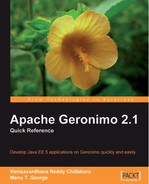Plugins
A Geronimo plugin is a predeployed configuration that contains a class loader description, GBeans, and other resources. An example is the Quartz plugin that, upon installation, provides sophisticated scheduling functionality to applications being deployed on Apache Geronimo. A plugin defines prerequisite configurations as well as dependencies that must be downloaded. As it is already processed by the deployer, a plugin JAR is directly extracted into the server's repository without going through a deployment step where the configuration is created. A plugin installation differs from a normal deployment in the way that any non-prerequisite dependencies for the plugin will be downloaded during installation. The prerequisite configurations must have already been deployed in the server for the plugin to be installed. Note that in case of a regular deployment, all of the dependencies must already exist in the repository. Plugins can be installed by using the command-line deploy tool, the Administration Console, or the GShell.
Plugin catalog and plugin repository
A Plugin archive file contains a metadata file geronimo-plugin.xml under the META-INF directory. This geronimo-plugin.xml file contains descriptive information about the plugin, such as the plugin category, URL for a site that contains more information on the plugin, content to be added to config.xml for customization of GBeans, property values to be added to config-substitutions.properties, artifact aliases to be added to artifact-aliases.properties, a description of the content to be unpacked to the server directory, and so on. The information from multiple plugins is collected into a plugin catalog called geronimo-plugins.xml. A maven repository containing plugins and a plugin catalog is referred to as a plugin repository.
Custom server assemblies
Starting from v2.1, a Geronimo server is completely assembled out of plugins. This architecture provides the ability to assemble a server containing only selected configurations according to a user's interest, and the necessary dependencies. This provides the users with the ability to start with a full Java EE server, deploy the user's applications, and then extract a server with the minimum footprint required to run the user's applications. Assembling a server in this manner can be done using the Plugins portlet in the Administration Console or by using the assemble-server GShell command. Note that the org.apache.geronimo.assemblies/geronimo-boilerplate-minimal/2.1.4/jar configuration must be included in order to have a working server. Another way to create a custom server assembly is to use the car-maven plugin and build the server using Maven to include geronimo-boilerplate-minimal, along with your plugin(s) that need to be part of the server. See Chapter 9, Geronimo Plugins, for more details on creating custom server assemblies.
Extensible Administration Console
The flexible server assemblies require that the Administration Console is also flexible, in order to provide the administration functionality for the newly added components as plugins to be made available from a single place. New functions can be added to the Administration Console by installing Administration Console Extensions. This provides the plugin developers with the capability to package administration components along with the functional components of their plugin. See Chapter 9, Geronimo Plugins, for details on creating Administration Console Extensions.
